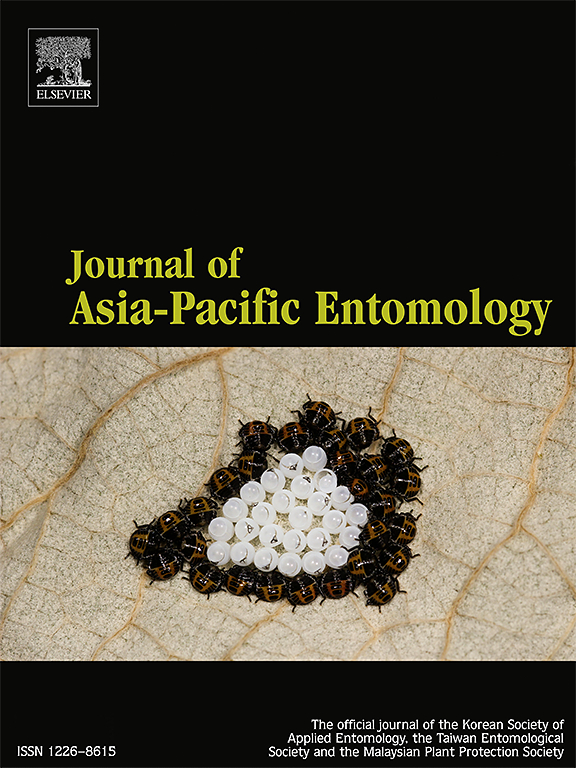β-异戊二酸对埃及伊蚊和致倦库蚊乙酰胆碱酯酶抑制活性的硅分子对接分析
IF 1.3
3区 农林科学
Q3 ENTOMOLOGY
引用次数: 0
摘要
蚊媒疾病日益流行,对公共卫生和经济构成严重威胁,蚊子种群出现杀虫剂抗药性进一步加剧了这一威胁。虽然传统杀虫剂是有效的,但它们有助于环境退化和耐药性的发展。本研究研究了β-异戊酸的杀虫潜力。β-异戊酸是一种植物源化合物,可靶向乙酰胆碱酯酶(AChE),破坏埃及伊蚊和致倦库蚊两种主要蚊媒的神经传递。采用分子对接的方法对β-异戊二酸与双硫磷的AChE结合亲和力和相互作用模式进行评价和比较。从PubChem中检索配体结构,并使用ChemDraw和PRODRG服务器进行优化。Ae. AChE1的同源性模型。埃及伊蚊和Cx。基于冈比亚按蚊AChE突变体的晶体结构构建了致倦库蚊。对接仿真使用AutoDock工具,采用基于网格的方法和拉马克遗传算法进行。在这两个物种中,β-异戊酸均与AChE1具有较强的结合亲和力,Ae的结合能为-8.2 kcal/mol。而Cx为-8.5 kcal/mol。致倦蚊,值与双硫磷相当(分别为-8.7千卡/mol和-9.1千卡/mol)。这些发现表明β-异戊酸可能是一种生态友好的候选杀虫物质,可以抑制乙酰胆碱酯酶并损害蚊子的功能。鉴于其良好的结合特性,β-异戊二酸有潜力成为可持续的蚊虫控制替代品。需要进一步的体内研究来验证其有效性和安全性。本文章由计算机程序翻译,如有差异,请以英文原文为准。

In silico molecular docking analysis on acetylcholinesterase (AChE) inhibition activity on Aedes aegypti and Culex quinquefasciatus by β-isocostic acid
The increasing prevalence of mosquito-borne diseases poses serious public health and economic threats, further exacerbated by the emergence of insecticide resistance in mosquito populations. Although conventional insecticides are effective, they contribute to environmental degradation and resistance development. This study investigates the insecticidal potential of β-isocostic acid, a plant-derived compound that targets acetylcholinesterase (AChE) to disrupt neurotransmission in Aedes aegypti and Culex quinquefasciatus, two major mosquito vectors. Molecular docking was employed to evaluate and compare the AChE binding affinity and interaction patterns of β-isocostic acid with that of the standard insecticide temephos. Ligand structures were retrieved from PubChem and optimized using ChemDraw and the PRODRG server. Homology models of AChE1 for Ae. aegypti and Cx. quinquefasciatus were constructed based on the crystal structure of an Anopheles gambiae AChE mutant. Docking simulations were performed using AutoDock Tools with a grid-based approach and the Lamarckian Genetic Algorithm. β-Isocostic acid demonstrated strong binding affinity to AChE1 in both species, with binding energies of –8.2 kcal/mol for Ae. aegypti and –8.5 kcal/mol for Cx. quinquefasciatus, values comparable to those of temephos (–8.7 kcal/mol and –9.1 kcal/mol, respectively). These findings suggest that β-isocostic acid may serve as an eco-friendly insecticidal candidate, inhibiting AChE and impairing mosquito function. Given its promising binding profile, β-isocostic acid has potential as a sustainable alternative for mosquito control. Further in vivo studies are warranted to validate its efficacy and safety.
求助全文
通过发布文献求助,成功后即可免费获取论文全文。
去求助
来源期刊

Journal of Asia-pacific Entomology
Agricultural and Biological Sciences-Insect Science
CiteScore
2.70
自引率
6.70%
发文量
152
审稿时长
69 days
期刊介绍:
The journal publishes original research papers, review articles and short communications in the basic and applied area concerning insects, mites or other arthropods and nematodes of economic importance in agriculture, forestry, industry, human and animal health, and natural resource and environment management, and is the official journal of the Korean Society of Applied Entomology and the Taiwan Entomological Society.
 求助内容:
求助内容: 应助结果提醒方式:
应助结果提醒方式:


